Overview
This article delineates five essential steps to enhance stakeholder satisfaction in project management:
- Identifying stakeholders
- Creating engagement strategies
- Implementing effective communication
- Monitoring progress
Evidence supports that organizations actively involving stakeholders achieve significantly higher success rates in their initiatives. This underscores the critical role of stakeholder satisfaction in driving project success.
Introduction
In the intricate landscape of project management, stakeholder satisfaction stands as a pivotal determinant of success. As organizations strive to meet the diverse needs and expectations of their stakeholders, understanding the nuances of this satisfaction becomes essential. This article explores actionable steps that project managers can implement to enhance stakeholder satisfaction, ultimately leading to improved project outcomes. However, with many organizations failing to effectively monitor and engage their stakeholders, how can managers ensure that they not only meet but exceed the expectations of those involved?
Define Stakeholder Satisfaction in Project Management
Stakeholder satisfaction in project management is defined as the degree to which the needs, expectations, and interests of the involved parties are met throughout the lifecycle. This concept encompasses various aspects, including the effectiveness of communication, the quality of results, and the overall experience participants have with the team.
To effectively improve participant satisfaction, managers must first identify the specific criteria that individuals use to evaluate their contentment. These criteria typically include:
- Timely updates
- The quality of deliverables
- Responsiveness to feedback
By establishing these benchmarks, managers can create a structured framework for assessing and enhancing participant satisfaction, ultimately leading to improved outcomes.
For instance, organizations that actively involve participants report a 78% success rate in their initiatives, compared to only 40% for those with less involvement. Moreover, firms that prioritize the interests of involved parties perform 15% better in their strategies, highlighting the critical importance of stakeholder satisfaction in project management for achieving initiative success. A recent study revealed that companies incorporating input from interested parties into their processes experienced a 30% higher adoption rate of their initiatives.
However, it is essential to note that few organizations monitor stakeholder satisfaction in project management, which presents a challenge in fully understanding and improving this crucial aspect of management.
As Gartner emphasizes, assessing participant satisfaction is vital for success, underscoring the need for managers to prioritize this area.
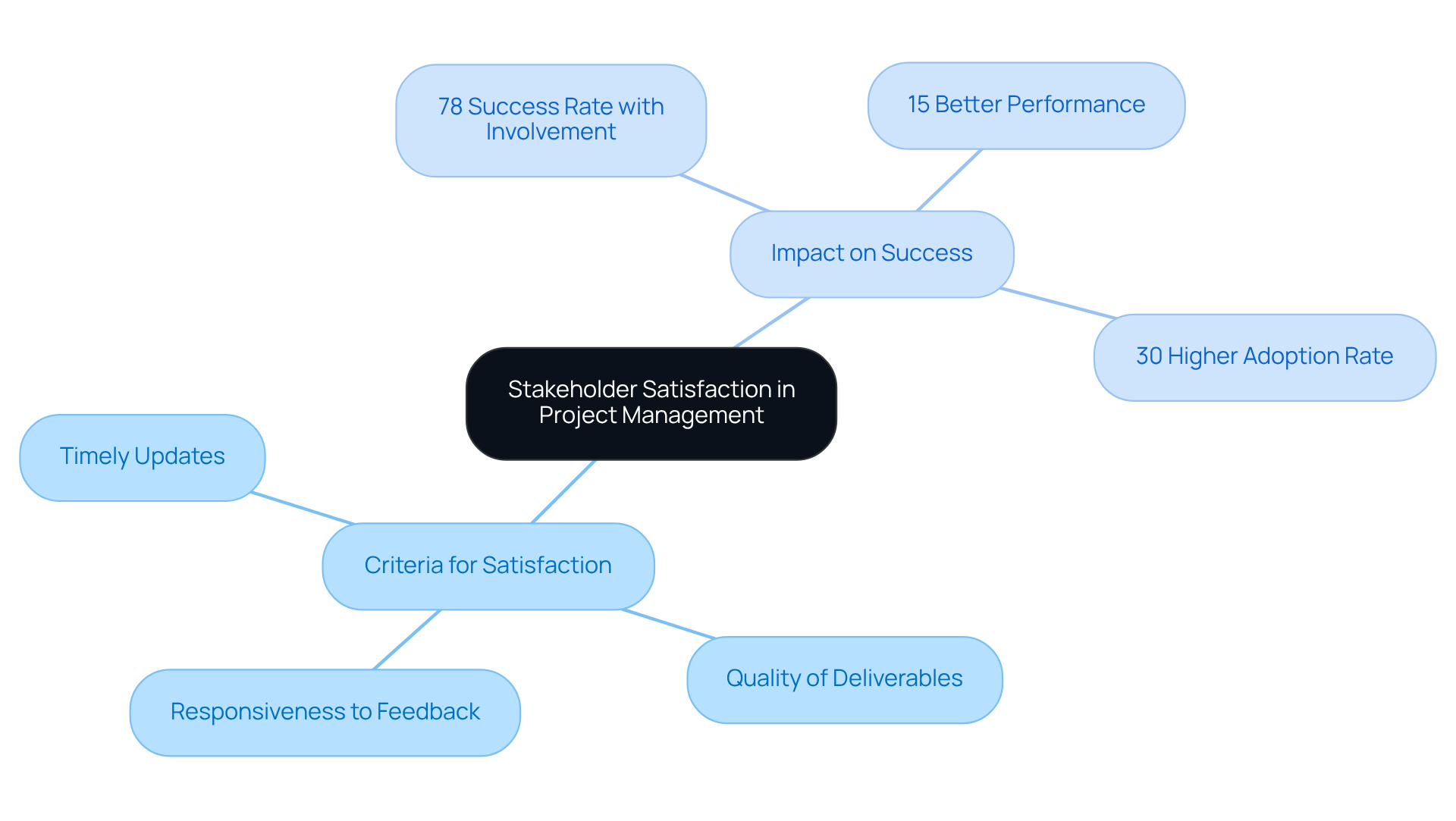
Identify and Analyze Your Stakeholders
To effectively identify and analyze stakeholders, follow these essential steps:
-
Create a Stakeholder List: Compile a comprehensive list of all individuals and groups with an interest in or affected by the project. This encompasses both internal participants, such as team members and management, and external parties, including clients, suppliers, and community members.
-
Evaluate Influencer Impact and Engagement: Employ tools such as the Power-Interest Grid to classify influencers based on their impact and engagement levels. This classification assists in prioritizing involvement efforts, ensuring that those with the most significant impact on the project are addressed first.
-
Gather Information: Conduct interviews, surveys, or focus groups to collect insights regarding the expectations, concerns, and preferences of interested parties. This information is essential for customizing interaction strategies that connect with each group of interested parties.
-
Document Findings: Create a participant analysis matrix that summarizes the gathered information, detailing each individual's influence, interest, and specific needs. This matrix acts as an essential reference throughout the endeavor, guiding engagement and interaction strategies.
-
Involve Interested Parties Consistently: Initiatives with consistently involved interested parties are considerably more likely to achieve their initial objectives. Research shows a success rate of 83% for initiatives that emphasize relationships with concerned individuals. By promoting transparent dialogue and teamwork, organizations can improve participant satisfaction and results. As highlighted by the Project Management Institute (PMI), 'Projects with actively involved participants were up to 70% more likely to achieve their initial objectives.' Moreover, findings from the case analysis on participant involvement demonstrate that effective interaction greatly impacts project results, further highlighting the significance of these approaches.
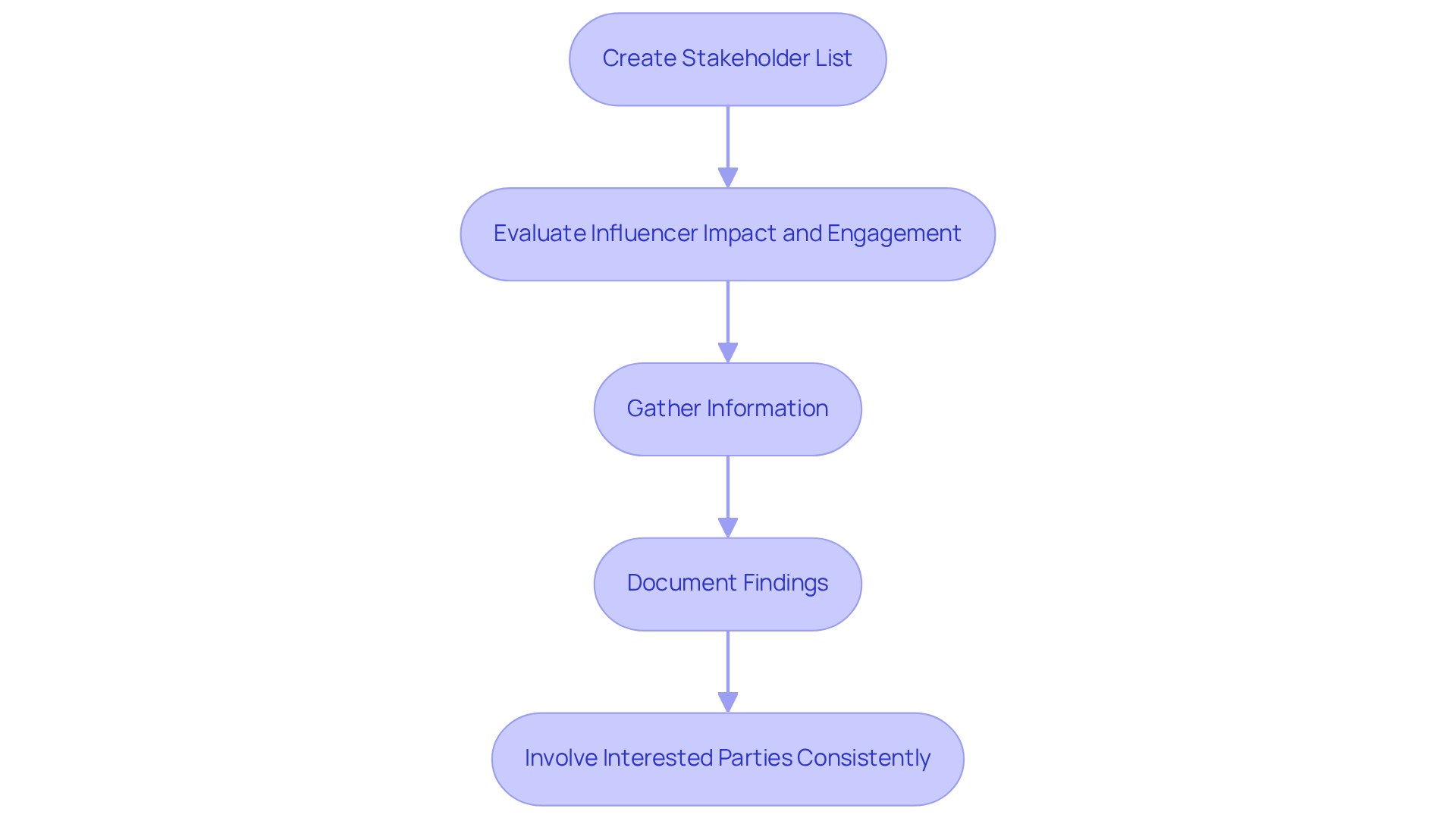
Create a Customized Stakeholder Engagement Strategy
To create a customized stakeholder engagement strategy, follow these steps:
-
Define Engagement Objectives: Clearly outline what you aim to achieve with each group of interested parties. Objectives may include increasing awareness, gathering feedback, or fostering collaboration. Studies show that companies engaging participants in decision-making are 30% more likely to achieve goals, highlighting the significance of clearly defined objectives.
-
Select Engagement Techniques: Choose suitable methods for involving each interest group based on their preferences and the characteristics of the initiative. Options may include meetings, workshops, newsletters, or online platforms. Efficient exchange of information is vital; organizations that emphasize participant feedback frequently attain improved project outcomes.
-
Create a Messaging Strategy: Establish a messaging strategy that outlines how and when you will interact with involved parties. This plan should encompass regular updates, feedback systems, and chances for participants to express their concerns. Open information channels improve transparency and trust, which are essential for sustaining participant commitment.
-
Assign Responsibilities: Designate team members responsible for engaging with specific stakeholders. This ensures accountability and helps maintain consistent communication. Engaging key employees significantly boosts the success rate of transformations, making it essential to involve the right people.
-
Review and Adjust: Regularly assess the involvement strategy to ensure it remains effective and relevant. Be ready to modify your strategy according to input from interested parties and evolving circumstances. Ongoing involvement facilitates the recognition of new participants and adjustment of approaches, ensuring all pertinent parties are engaged in the initiative.
By putting these measures into practice, organizations can cultivate deeper connections with interested parties, leading to enhanced project results and improved stakeholder satisfaction in project management.
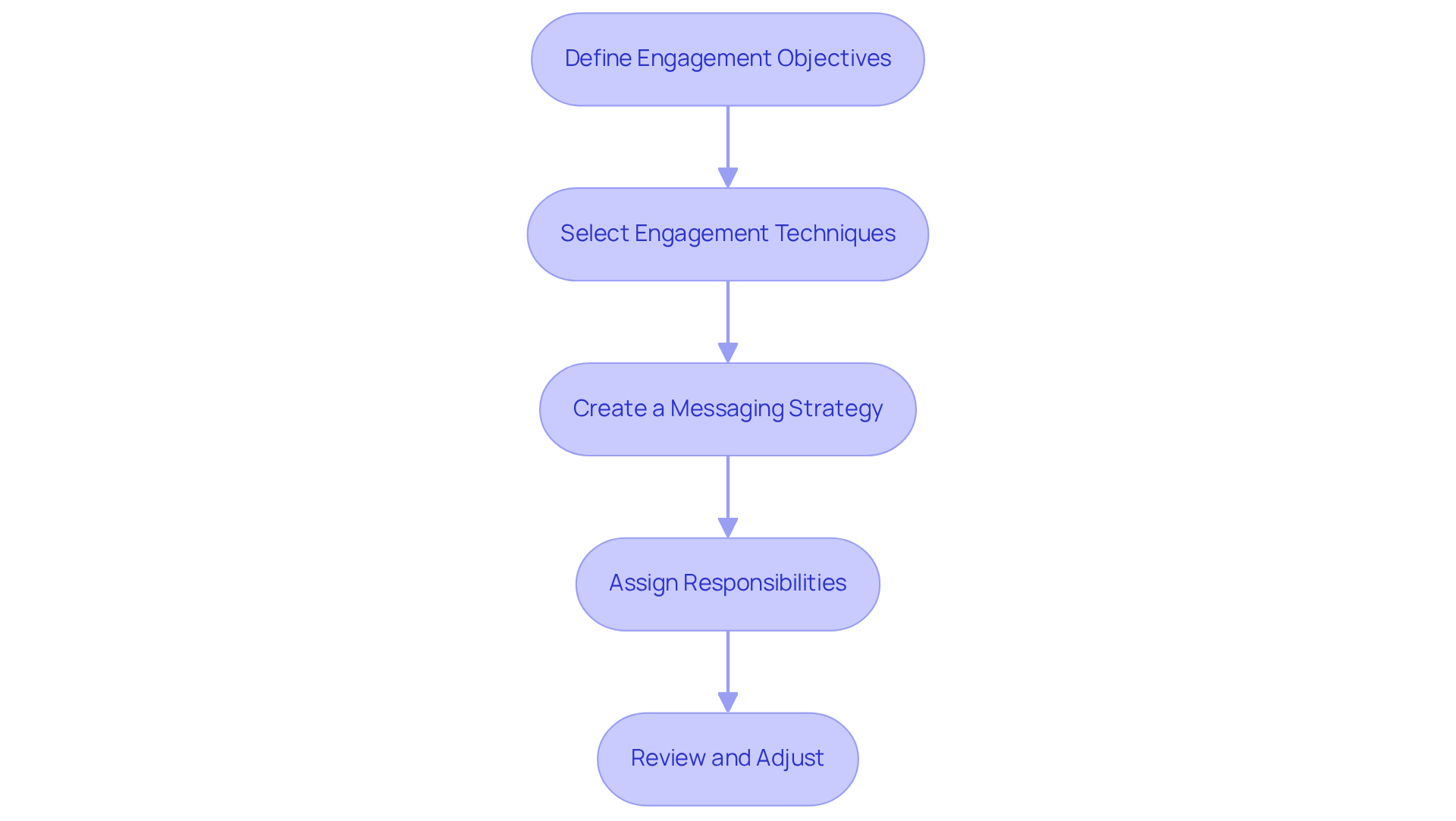
Implement Effective Communication Channels
To implement effective communication channels, consider the following steps:
-
Identify Preferred Channels: Evaluate the favored methods of interaction for each stakeholder group. Options may include email, phone calls, video conferencing, or face-to-face meetings. Understanding these preferences is crucial for ensuring stakeholder satisfaction in project management, as 96% of employees desire a more compassionate method of interaction. Moreover, providing a range of interaction methods accommodates various learning styles and preferences, improving overall involvement.
-
Establish a Communication Schedule: Create a consistent timetable for regular updates and check-ins with involved parties. This consistency promotes involvement and confidence, which is essential for achieving stakeholder satisfaction in project management, especially since 70% of change initiatives fail due to inadequate participant interactions. Consequently, consistent interaction aids in ensuring stakeholder satisfaction in project management by keeping all stakeholders aligned and informed.
-
Utilize Technology: Leverage management tools and platforms that enhance communication and collaboration. Instruments such as Slack, Microsoft Teams, and specialized task management software can enhance interactions. For instance, using Slack for real-time updates can significantly improve responsiveness and engagement among team members, with 72% of users reporting improved customer experiences through such tools.
-
Foster Input: Establish channels for participants to share their thoughts on project advancement and information effectiveness. This can be achieved through surveys, feedback forms, or informal discussions. Involving interested parties can enhance stakeholder satisfaction in project management, resulting in a 15% rise in employee retention. As Esraa Ali noted, effective interaction is crucial in the workplace to ensure stakeholder satisfaction in project management, keeping all team members on the same page and working towards common goals.
-
Document Interaction: Keep records of all exchanges with interested parties, including meeting notes and feedback received. This documentation is crucial for monitoring involvement efforts and guiding future strategies, as 63% of respondents have indicated wasting time due to messaging problems. Including case studies that showcase the effect of effective communication on participant involvement can further highlight the significance of this practice.
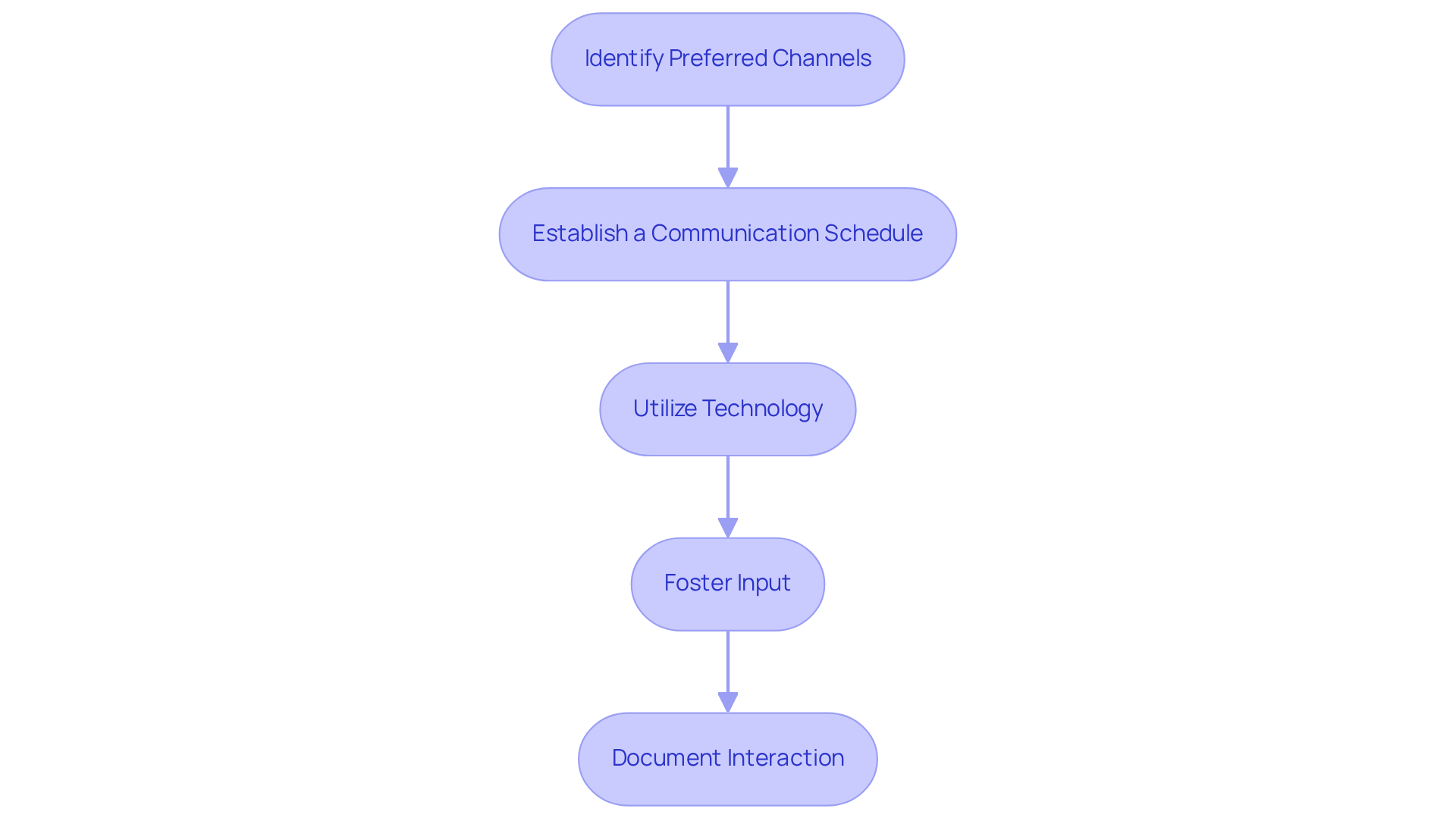
Monitor and Adjust Engagement Strategies
To effectively monitor and adjust engagement strategies, consider the following steps:
-
Set Key Performance Indicators (KPIs) to evaluate stakeholder satisfaction in project management and the effectiveness of outreach efforts. Examples include response rates, feedback scores, and participation levels in engagement activities. Employing KPIs enables a measurable evaluation of participant interactions and aids in testing hypotheses to achieve the highest return on invested capital.
-
Regularly Gather Feedback: Establish a continuous feedback loop with involved parties through various methods such as surveys, interviews, and informal check-ins. This ongoing collection of insights is crucial for understanding stakeholder satisfaction in project management and identifying areas for improvement. Organizations that actively seek feedback can significantly enhance their interaction strategies, which is essential for improving stakeholder satisfaction in project management by applying lessons learned from past interactions.
-
Analyze Engagement Data: Conduct a thorough examination of the feedback and information gathered to uncover trends and patterns related to stakeholder satisfaction in project management. Recognizing areas where participation may be insufficient or where involved parties raise issues is crucial for proactive management. Monitoring metrics such as website traffic, social media interaction, and event participation can provide valuable insights into stakeholder satisfaction in project management, enabling real-time business analytics via the client dashboard to consistently assess involvement health.
-
Make Adjustments: Based on the insights gained from the analysis, refine your interaction strategies accordingly. This may involve modifying communication methods, increasing the frequency of updates, or directly addressing specific concerns of involved parties to enhance their experience. As Stephen Townsend observed, "Emphasizing results instead of outputs can allow for the exploration of various options," which can be utilized to enhance interaction strategies and aid a shortened decision-making cycle.
-
Share Modifications: Keep interested parties updated about any alterations made to involvement strategies. Transparency in communication fosters trust and reinforces the organization's commitment to addressing their needs, which ultimately leads to stronger relationships and enhances stakeholder satisfaction in project management. A structured engagement strategy ensures stakeholders receive relevant updates and timely feedback, contributing to continuous business performance monitoring.
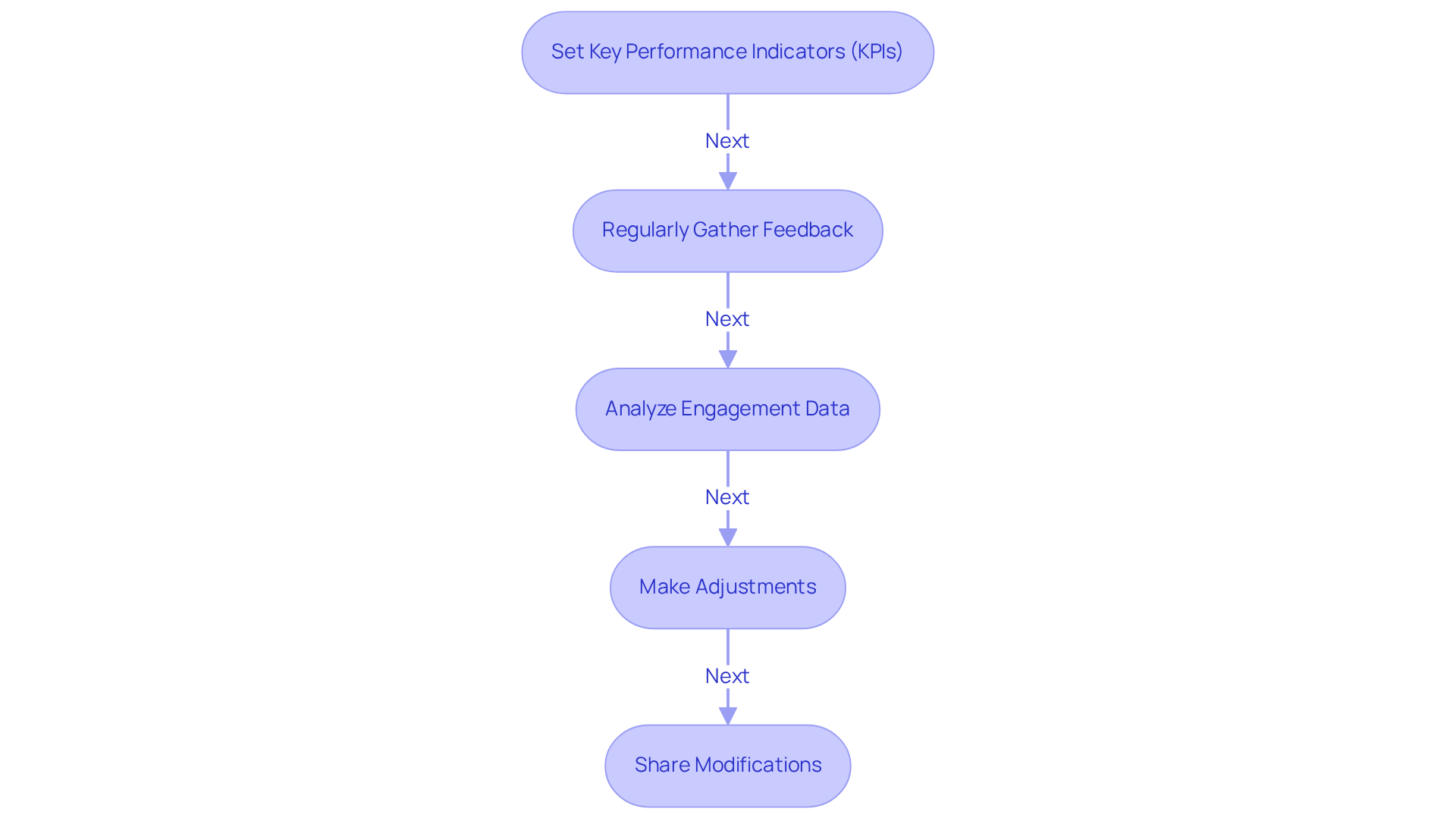
Conclusion
Enhancing stakeholder satisfaction in project management is essential for achieving successful project outcomes. By understanding the needs and expectations of all parties involved, organizations can create a framework that prioritizes effective communication, quality deliverables, and responsiveness to feedback. This structured approach not only improves participant satisfaction but also leads to higher success rates for initiatives.
The article outlines several key strategies for enhancing stakeholder satisfaction, including:
- Identifying and analyzing stakeholders
- Creating customized engagement strategies
- Implementing effective communication channels
- Continuously monitoring and adjusting these strategies
Each step emphasizes the importance of involving stakeholders throughout the project lifecycle, ensuring that their voices are heard and their concerns addressed. The data presented highlights that organizations that actively engage their stakeholders report significantly better outcomes, reinforcing the critical role of stakeholder satisfaction in project management.
Ultimately, prioritizing stakeholder satisfaction is not just a best practice; it is a fundamental aspect of successful project management. By fostering open communication, valuing feedback, and adapting strategies based on stakeholder input, organizations can build stronger relationships and drive project success. Embracing these principles will not only enhance stakeholder satisfaction but also create a more collaborative and productive project environment.
Frequently Asked Questions
What is stakeholder satisfaction in project management?
Stakeholder satisfaction in project management is the degree to which the needs, expectations, and interests of the involved parties are met throughout the project lifecycle. It includes aspects like communication effectiveness, quality of results, and the overall experience of participants with the team.
What criteria do managers typically use to evaluate stakeholder satisfaction?
Managers typically evaluate stakeholder satisfaction based on criteria such as timely updates, the quality of deliverables, and responsiveness to feedback.
How does stakeholder involvement impact project success rates?
Organizations that actively involve participants report a 78% success rate in their initiatives, compared to only 40% for those with less involvement. Additionally, firms prioritizing the interests of involved parties perform 15% better in their strategies.
What are the steps to identify and analyze stakeholders?
The steps to identify and analyze stakeholders include: 1. Creating a comprehensive stakeholder list. 2. Evaluating influencer impact and engagement using tools like the Power-Interest Grid. 3. Gathering information through interviews, surveys, or focus groups. 4. Documenting findings in a participant analysis matrix. 5. Involving interested parties consistently throughout the project.
Why is it important to involve interested parties in projects?
Consistently involving interested parties significantly increases the likelihood of achieving project objectives. Research indicates a success rate of 83% for initiatives that emphasize relationships with concerned individuals, and projects with actively involved participants are up to 70% more likely to achieve their initial objectives.
What challenges do organizations face regarding stakeholder satisfaction monitoring?
Few organizations monitor stakeholder satisfaction in project management, which presents a challenge in fully understanding and improving this crucial aspect of management.




